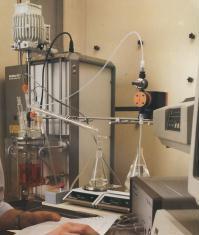20 most dangerous compounds. Published the most dangerous product listings.
Published the most dangerous product listings

The list of most dangerous substances among the usual ones is written by ATSDR (Agency for Toxic Substances and Disease Registry) and EPA (Environmental Protection Agency). Each chemical compound is identified with the number of a ranking and is based on the health report produced by the organization ATSDR. Information on each list and compound is provided on the Internet at
www.atsdr.cdc.gov/ 99list.html.
The first twenty are:
1. Arsenic
It is a powerful poison. It is mixed with other elements. When combined with oxygen, chlorine or sulfur it forms an inorganic arsenic and with carbon or organic hydrogen. The inorganic is the most dangerous of both. It is used in wood protective compounds.
2. Lead
It is a gray-bluish metal. It is found in small amounts on the earth's surface. It is mainly found in mines, factories and fuels. The nervous system, kidneys and immune system are most affected.
3. Mercury
It is a silver shiny liquid metal. Some small organisms synthesize mercury compounds. It is used industrially in the production of chlorine gas and caustic soda. It is usually present in thermometers, fillings and batteries. It affects the brain, kidneys, and fetuses.
4th Vinyl chloride
It is a gas without color and aroma. Used to make PVC. High concentrations can cause dizziness, loss of consciousness, and even death. Prolonged inhalation at low concentrations can damage the nervous system and cause liver cancer.
5. Benzene
It is a colorless and scented liquid. It is one of the most widely used substances in the industry. It evaporates very quickly and is flammable. It affects the bones and can cause anemia and leukemia.
6º Polychlorinated biphenyls (PCB)
They are groups of compounds that contain chlorine atoms. Some solid and other oily liquids. Among others, they are good insulators and lubricants. Production has been banned in the United States, but it can still be found as a pollutant. Membrane the nose and throat.
7. Cadmium
It is a metal in nature. Because of its physical characteristics it has multiple uses. It is obtained in the production of other metals. It is found in contaminated food and cigarette smoke. Its greatest incidence in the lungs, kidneys and digestive tract.
8th. Benzo[a]pyrene
Aromatic hydrocarbon is polycyclic. It is produced by burning gasoline, trash, animals or plants. That is why it is in smoke or soot. It is not very studied but according to laboratory experiments it produces cancer.
9. Polycyclic aromatic hydrocarbons
It is a set of approximately one hundred substances. They are generated in incomplete burning. They are solid white or yellowish in pure state. It has been observed in laboratories in animal reproduction. They can cause cancer but have not been shown for the moment.
10. Benzo[b]fluoradium
Another polycyclic aromatic hydrocarbon. It is generated in the burning of fuels and organic matter. Contact with animal skin can cause cancer. Nor has the research of this molecule deepened.
11. Chloroform
It is a liquid without color and with aroma and sweet taste. Despite its use as an anesthetic, it is currently managed in the production of other compounds. Produces short-term fatigue and headache. It may be related to liver and kidney cancer.
12. DDT
It is a white crystalline solid widely used as an insecticide. The molecule is chlorine. It excites the nervous system and can cause alterations in liver proteins.
13 and 14. Arokloro 1260 and 1254
They belong to the group of chlorinated biphenyls. And like these, they have more influence on the nose and throat.
15. Trichloroethylene
It is a clear non-flammable liquid. It smells good but burns the mouth. Very soluble in water. It is found in the air and on the grounds. It is used in glues and eliminator liquids. It can damage the liver, lungs, and heart.
16. Chromium
It is found in nature in the form of varied compounds. It has three main forms: chrome metal, chrome III and chrome IV. Only the second of them is vital, but within a range of quantities. It produces lung diseases and allergies.
17. Dibenzo[a,h]antracene
Another polycyclic aromatic hydrocarbon. It is common in smoke and soot. It can fall into water and soil by joining with particles in the air. Like its members, it can be said that it can cause cancer. At least in laboratories.
18. Dieldrin
It is a white powder with little odor. It has been used as an insecticide. Currently it has been banned for its impact on the environment, except in the case of termites. It builds up in the body and attacks the nervous system.
19. Hexachlorobutadiene
It is a clear liquid with a characteristic odor. Also called perchlorobutadiene. Pollutant of air and water. In landfills it is very abundant. It affects the liver and can cause kidney tumors.
20. DDE
It is a compound of the DDT group. However, DDE has no commercial use. DDT is inflated into the soil to form DDE. It affects the nervous system.
Buletina
Bidali zure helbide elektronikoa eta jaso asteroko buletina zure sarrera-ontzian











